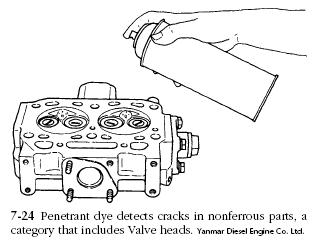Cylinder heads should be crack tested before and after resurfacing. The apparatus used for ferrous parts generates a powerful magnetic field that passes through the part under test. Cracks and other discontinuities at right angles to the field become polarized and reveal their presence by attracting iron filings. The magnetic particle test, known generically by the trade name Magnaflux, is useful within its limits. It cannot detect subsurface flaws, nor does it work on nonferrous metals. But fatigue and thermal cracks always start at the surface, and will be seen.
Nonferrous parts are tested with a penetrant dye (Fig. 7-24). A special dye is sprayed on the part, the excess is wiped off, and the part is treated with a developer that draws the dye to the surface, outlining the cracks. In general, penetrant dye is considered less accurate than Magnaflux, but, short of x-ray, it remains the best method available for detecting flaws in aluminum and other nonmagnetic parts.
Neither of these detection methods discriminates between critical and superficial cracks. The cylinder head might be fractured in a dozen places and still be serviceable. But cracks that extend across a pressure regime—that is, from the combustion chamber, cylinder bore, water jacket, or oil circuits—require attention.
Mack and a handful of other manufacturers build surface discontinuities into the roofs of the combustion chambers, which appear as cracks under Magnafluxing, but which are intended to stop crack propagation. These built-in “flaws” run true and straight, in contrast to the meandering paths followed by the genuine article. In general, cracks that are less than a 1/2 in. long and do not extend into the valve seat area might be less serious than they appear. Short cracks radiating out from precombustion chamber orifices can also be disregarded.
